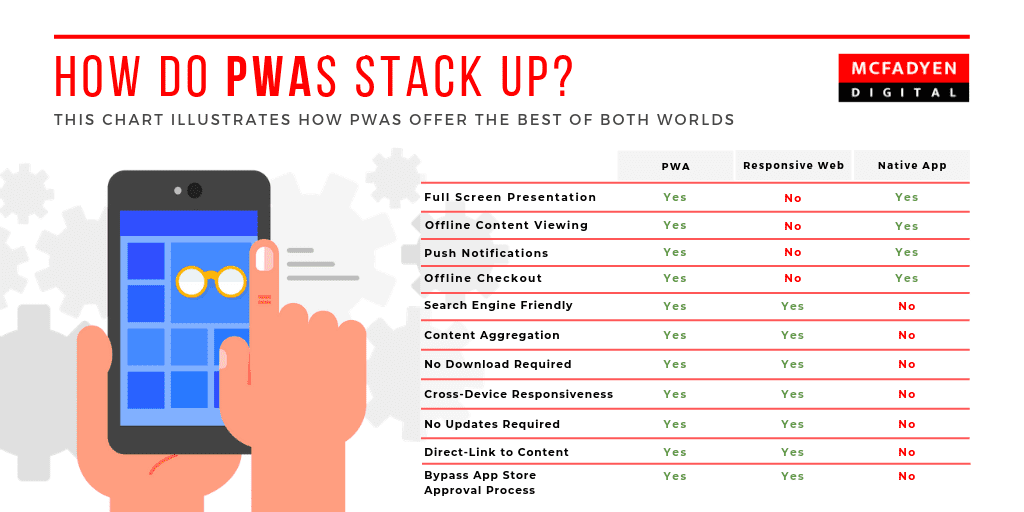
Progressive Web Apps (PWA) are billed to be the next big thing in mobile content and a game changer for the mobile web. Though PWAs were initially introduced by Google way back in 2015, they have gained lot of traction in the last 2 years owning to some of the big names jumping on to the PWA bandwagon. Also the fact that its relatively easy to develop and can result in some instant wins from a user experience perspective means that it will continue to evolve and gain more and more attention from brands, marketers and ecommerce site operators.
What is really driving their growth is the growth of mobile adoption, in general. Modern customers are living on their mobile devices. In fact, in the last year, 82% of Internet users in the United States have used a mobile device to make an online purchase (Statista). The challenge for eCommerce operators is no longer “if” but “how” to think mobile-first.
 What is PWA?
What is PWA?
While mobile websites and responsive designs are relatively commonplace and easy to pull off, they lack these user experience aspects seen in native apps. Although these naive apps can provide a fantastic user experience, they can have high barriers to adoption and typically need significant initial buy-in from the consumer in order to justify the investment. This is where PWA comes into the picture, combining the best of both worlds. A PWA takes advantages of the latest web technologies to achieve the great mix of bridging the gap between native mobile app and responsive website.
You can think of PWA as a website built using web technologies and accessed via a browser, but that feels like an app. This is made possible due to the recent browser technology enhancements, the availability of native-OS elements such as service workers, local caching, and access to push API’s. The technologies allow app-like experiences from these PWAs such allowing users to put web app icon on their home screen, receive push notification, stay connected even when offline.
While PWA does a great job of bridging the gap between mobile apps and responsive website, some of its best features also point to inherent limitations:
1. With PWAs being authored in JavaScript, they take a higher energy toll on a mobile device, meaning a PWA can run down battery life faster than a native app.
2. While PWAs can access many native OS features, some still remain out of reach, such as NFC (near – field communication), Bluetooth, and proximity sensors etc.
3. Since PWA is a newer technology, it may have compatibility issues with older devices and operating systems. While Apple now al lows al l updated devices to run PWAs, they still don’t al low access to many key features like Touch ID, FaceID, Beacons, etc.
4. For heavier – lifting, bandwidth- intensive tasks, PWA will not be as smooth or powerful as a native app because JavaScript is a single- threaded language, which limits performance.
Building a PWA for Oracle Commerce Cloud or Oracle Commerce/ATG
As seen in the diagram below of a McFadyen PWA Shop framework developed on top of OCC, a PWA site integrated with OCC contains the presentation layer, the API layer, and the platform layer. In this example a PWA front end has been constructed on top of the OCC APIs and using the open source Elasticsearch search engine. The Service Worker interfaces with the local Operating System’s native features while the OCC Data Pump handles data transit. The INDEXDB caches data locally to the device and the Node.js component Kue is used for priority queuing of requests. OCC handles all transactions and back-end functions.

 To understand more about building PWA’s for Oracle Ecommerce platforms, download our new Ebook – PWA for Oracle Ecommerce. It has in-depth information on the following:
To understand more about building PWA’s for Oracle Ecommerce platforms, download our new Ebook – PWA for Oracle Ecommerce. It has in-depth information on the following:
1. What are the benefit of PWA
2. How is PWA driving eCommerce growth
3. Why it’s a must have tool in the arsenal for eCommerce players.
4. The business case for PWA, why it makes sense to invest in one.
5. How to create a PWA using McFadyen’s storefront (PWA Shop) on Oracle Commerce Cloud/ ATG
McFadyen Digital has helped some of the world’s largest brands deliver innovative Ecommerce and online marketplace solutions to their customers for over the past thirty years. Please contact us at info@mcfadyen.com if you’d like to have a conversation about taking your own digital commerce experience to the next level.
AUTHOR
Stephen George
Director, Digital Content
McFadyen Digital
Connect with Stephen
Related Articles
Turn Insight Into Impact.
Start Today.





